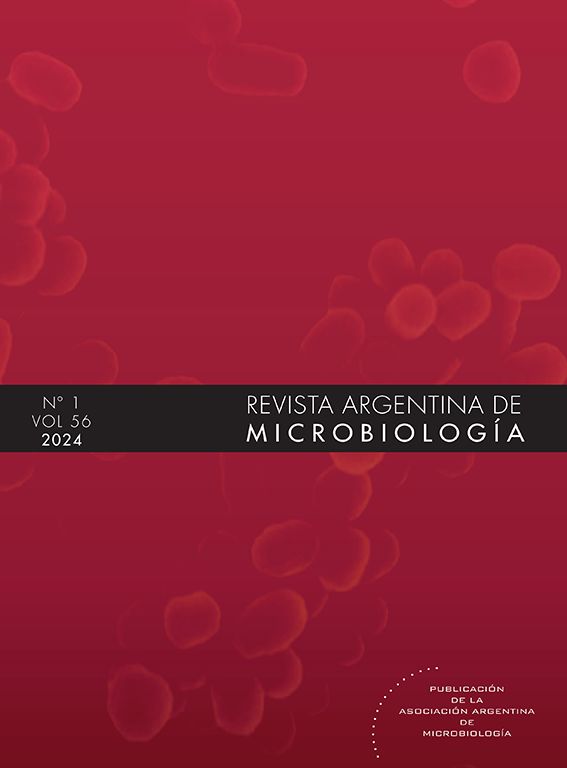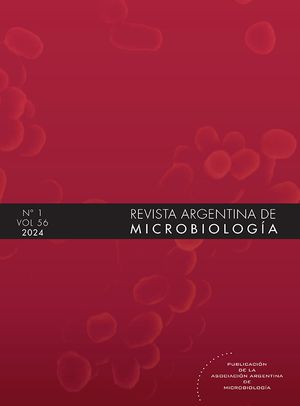Revista Argentina de Microbiología is published by the Asociación Argentina de Microbiología (AAM) on a quarterly basis. The aim of this journal is to publish current scientific works in the different areas of Microbiology and Parasitology. Some of the topics considered of special interest are: infections caused by bacteria, fungi, parasites and viruses; mechanisms of pathogenicity, and virulence factors; resistance to antimicrobial agents; taxonomy; epidemiology and phenotypic, immunologic and molecular diagnostic methods. RAM also publishes articles on microbial ecology and diversity, zoo- and phytopathogens and microorganisms of value for food, agronomic, industrial and environmental applications. With the purpose of covering basic aspects of research in the area, the journal is also interested in the publication of manuscripts on microorganism genomics, proteomics and enzymology, as well as in those articles dealing with regional impact.
Indexed in:
EMBASE, MEDLINE, PUBMED, LILACS, LATINDEX, SciELO, SCIENCE CITATION INDEX EXPANDED y MEDES
See moreFollow us:
The Impact Factor measures the average number of citations received in a particular year by papers published in the journal during the two preceding years.
© Clarivate Analytics, Journal Citation Reports 2022
SRJ is a prestige metric based on the idea that not all citations are the same. SJR uses a similar algorithm as the Google page rank; it provides a quantitative and qualitative measure of the journal's impact.
See moreSNIP measures contextual citation impact by wighting citations based on the total number of citations in a subject field.
See moreArticles in press are accepted, peer reviewed articles that are not yet assigned to volumes/issues, but are citable using DOI. More info
- •
Pseudomycetoma is a rare chronic granulomatous reaction that surrounds fungal hyphae.
- •
Mycobacterium genavense does not grow on conventional solid and liquid media.
- •
Severely immunosuppressed patients may present co-infections.
- •
En agua de mar de la costa marplatense se confirmó la presencia de Acanthamoeba spp.
- •
Acanthamoeba spp. sobrevive a condiciones ambientales diversas por su adaptabilidad.
- •
Se reportó por primera vez Acanthamoeba spp. en agua de mar en Argentina.
- •
Candida can colonize and invade human surfaces, causing severe infections.
- •
Incidence of candidemia in our study was higher than Latin American.
- •
Non-albicans Candida species were the most frequent, including C. parapsilosis.
- •
Septic shock was the only one with a risk factor for mortality.
- •
Implementing infection control strategies to prevent candidemia and adverse outcomes.
- •
First report of feline sporotrichosis due to S. globosa in Argentina.
- •
Absence of zoonotic transmission through scratches from the sick cat is reported.
- •
The cat received itraconazole 10mg/kg/day for 3 months with a favorable evolution.
- •
E.coli diarreogénica fue detectada en el 14% (84/601) de los niños con diarrea.
- •
El patotipo EAEC fue prevalente y mostró un alto grado de diversidad genética.
- •
EAEC, ETEC, STEC, EPEC y EIEC fueron detectados en población menor de 5años.
- •
Entamoeba coli was the most prevalent species in Argentina populations studied.
- •
First molecular sequence of Entamoeba histolytica was recorded for Argentina.
- •
Among the Entamoeba complex species, Entamoeba dispar was more prevalent.

- Instructions for authors
- Submit an article
- Ethics in publishing
- Open Access
- Language Editing services











